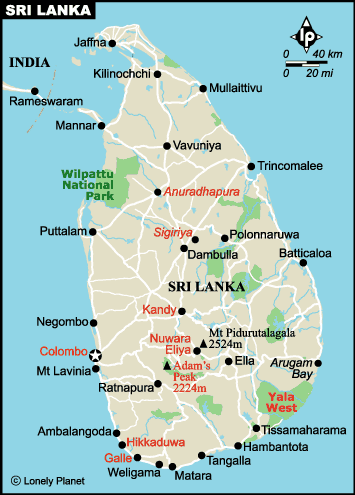The island of Sri Lanka (formerly Ceylon)

An introduction to a tropical paradise in the Indian Ocean
The Island of Sri Lanka lies 3 degrees north of the equator, 82 degrees east of Greenwich and 32 KM southeast of India. She occupies 65,610 sq Km (approximately 25,000 sq miles). She possesses tropical beaches, ancient monuments, rain forests, gorgeous waterfalls and many places to delight any person. The typically tropical climate with an average temperature of 270C fluctuates between 150 C in the highlands to 350C in certain areas of the lowlands.
Sri Lanka is mainly an agricultural country. She is self sufficient in her staple diet rice which is the largest cultivation. Tea, Coconut and Rubber are the main economic agricultural crops. Tea brings beauty as well as the foreign exchange to the country.
Sri Lanka, according to historical sources was settled by Indo-Aryans in the 6th century B.C. These Indo-Aryans were the first Sinhalese, who are 74% of the population today. The Indo-Aryans assimilated the indigenous inhabitants who are called Yakkhas in the historical chronicles. While the country had contacts in historical times with various foreign races, the Tamil and Muslim minorities of the present day had no settlements in the island until about the 10th century AD; that is to say about 1,500 years after the Sinhalese settlement.
From the 19th Century however, Tamil minority leaders have put forward various claims to political rights unsupported by fact or principle. From the early 1970s the Tamil political leadership has sought to enforce even more extreme claims with the use of violence. From 1949 the Tamils have been claiming the right to establish a Tamil state in over one third of the island. A Muslim theocratic party, the only such in a non-Muslim country, was formed in 1985 with the objective of establishing a Muslim political region in the island. The Indian Tamils, the first of whom were brought in the 19th century as labour by the British, were a floating population until the end of the Second World War. Though they were all entitled to Indian citizenship under Article 8 of the Indian constitution, they have been indiscriminately granted Sri Lankan citizenship by various Governments of independent Sri Lanka. The Indian Tamil leaders now expect to establish an Indian Tamil autonomous region in the heart of the country.
Minority politics particularly Tamil terrorism seek to wreck the political, financial and cultural life of the country and there is serious disruption already.
paradise
Because of her position at the southern tip of the Indian Sub-Continent Sri Lanka is often referred to as the Pearl of the Indian Ocean. In recorded history for over a thousand years travellers from all over the world came upon Sri Lanka or made the happy discovery by accident. Thus, this Isalnd Paradise was also called SERENDIP giving rise to the word 'serendipity' meaning 'making happy discoveries by accident'.
In the more recent times the strategic position of Sri Lanka (or Ceylon) became a magnet of attraction for the Western traveller or explorer to visit Sri Lanka. In the early 16th century the Portuguese were the first European power to realize the importance of Sri Lanka. Sri Lanka became a centre of the spice trade between the East and the West and the Portuguese were the first Europeans to set up their trading posts in Sri Lanka. They came in as explorers and traders and in due course schemed their way into becoming the masters of the coastline or the maritime areas of the Island. The Dutch followed them in the 18th century, but both these European nations could not capture or control the whole of the Island. The core or heart of the Sri Lankan nation survived the onslought of these two European powers until the beginning of the 19th century. It was only the British who came in the late 18th century and replaced the Dutch, were able to take control of the whole island in 1802. Thus Ceylon became the first Crown Colony of the British Empire in the East.
The Lion of Sri Lanka
A more realistic explanation for adopting the Lion as the national symbol was perhaps that the Lion represented the bravery of those early settlers (or sailors who crossed the Bay of Bengal) from North or North Eastern India and who spoke an Indo-Aryan dialect.
The lion though not native to Sri Lanka is the most important animal to the Sri Lankans. The national flag of Sri Lanka proudly displays the picture of a lion holding a sword. The legend goes that the first settlers of the Island of Lanka, who came from north India had their ancestry with a tribe or group of people who venerated the lions. The majority community of Sri Lanka are called "Sinhalese" meaning descended from a lion (or "Sinha" the Sinhalese word for lion).
Whilst the lion represents the Sinhalese community on the flag, the green and orange strips represent the minority communities in the Island. Sri Lanka has always been a modern secular democracy, with a written constitution safeguarding the rights and privileges of every citizen irrespective of their ethnic origin, colour, creed or religion.
Home page
Copyright © 2002 Warnaka.Tripod.com, All Rights Reserved.

